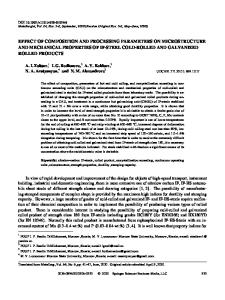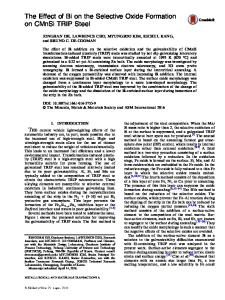Effect of processing variables on resultant microstructure and properties of C-Mn-Si steel
- PDF / 1,911,064 Bytes
- 5 Pages / 603.28 x 788 pts Page_size
- 9 Downloads / 299 Views
F I
0.5
S I
T II
U z~x
ZX
17"f ~7 o~ + VC0.75 O ~r + ~' + VC0.75 A 3~ + VC0.75
/k
O
0.4
ZX
re
0.3
Z~
I-.zLU t,.} z o
A
Z~
Z~
0.2
ZX
~
A
0
-
0 3' + VC0.75 ~
0
Z~ 0.60 • 0 . 0 5 % V Z~ 0.17 + 0.02%C
t~
z o r,,..
zX zX
ZX
z O k--
W I
A
POINT X
o o
o ~
t..}
8
+ ? + VC0,75
~
0
0.1 ~' .,, -,, ~'
. 0.95 + 0 . 1 0 % V
"" 9
O
c~+~,
0
0 ~
0.5
+ VC0,75
1.0 VANADIUM
CONCENTRATION,
1.5 %
Fig. 1 - - T h e iron-rich comer of the 993 ~ phase diagram for Fe-V-Si-C alloys containing 1 pet Si.
calculated from the known solubility product of vanadium carbide, after its correction for the effect of silicon on carbon activity.
Effect of Processing Variables on Resultant Microstructure and Properties of C-Mn-Si Steel
The assistance of P.E. Toohill, R . E . Stecik, and P.G. Fleck in the preparation of materials is appreciated. R.E. Stecik also assisted in the metallography and microscopy. H.S. Karp made the chemical analyses for carbon.
N.C. GOEL, G. RAI, and RAM AVTAR
REFERENCES 1. H.A. Wriedt and H. Hu: Chemical Metallurgy--A Tribute to Carl Wagner, N.A. Gokcen, ed., TMS-AIME, Warrendale, PA, 1981, pp. 171-94. 2. W. A. Fischer, K. Lorenz, H. Fabritius, A. Hoffmann, and G. Kalwa: Archiv. Eisenhiit., 1966, vol. 37, pp. 79-86. 3. T. Wada, H. Wada, J. E Elliott, and J. Chipman: Metall. Trans., 1972, vol. 3, pp. 2865-72.
Dual phase steels, by virtue of unique combination of strength, ductility, and high strain hardening index, are receiving increasing attention particularly in the automobile industry. Since the first commercial production of this steel in the year 1977,1 much of the research has involved determination of CCT diagrams for steel composition with varying amount of Mo, Cr, and Si 2'3'4 with the aim to produce dual phase steels in the hot rolled condition. However, one major drawback in this approach is that such CCT diagrams pertain to transformation of undeformed prior austenite. Although the CCT diagrams for deformed austenite are not extensively known, it has been estimated 5 that severe straining shifts the CCT diagram to the left by two to three orders of magnitude in time. Temperature of rolling, extent of hot deformation (strain rates of 1 to 10 s-l), and the subsequent cooling rates have a strong effect on the resulting transformation products and hence on the mechanical properties. In an attempt to shed more light on the effect of these processing parameters, laboratory scale hot rolling of high Mn and Si steel with chemical composition given in Table I N.C. GOEL, Senior Research Engineer, G. RAI, Research Manager, and RAM AVTAR, Research Engineer, are all with Structural Steel Group, Research and Development Centre for Iron and Steel, Steel Authority of India Ltd., Ranchi 834002, India. Manuscript submitted March 17, 1982.
308--VOLUME 14A, FEBRUARY 1983
ISSN 0360-2133/83/0211-0308500.75/0 9 1983 AMERICAN SOCIETY FOR METALS AND THE METALLURGICALSOCIETY OF AIME
METALLURGICAL TRANSACTIONS A
Table I.
Chemical Composition of the Steel (Wt Pct)
C
Mn 1.5
0.1
Data Loading...











